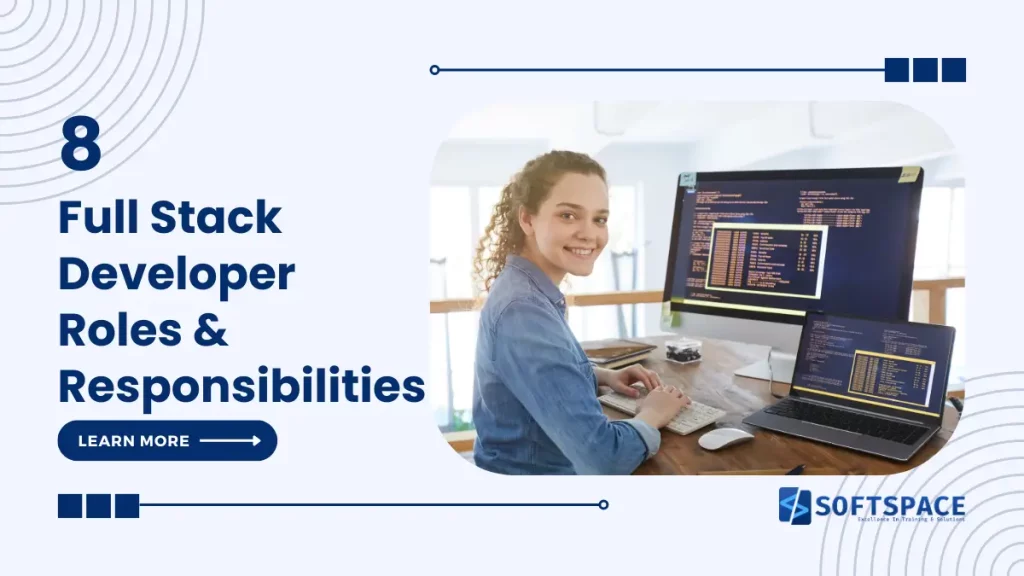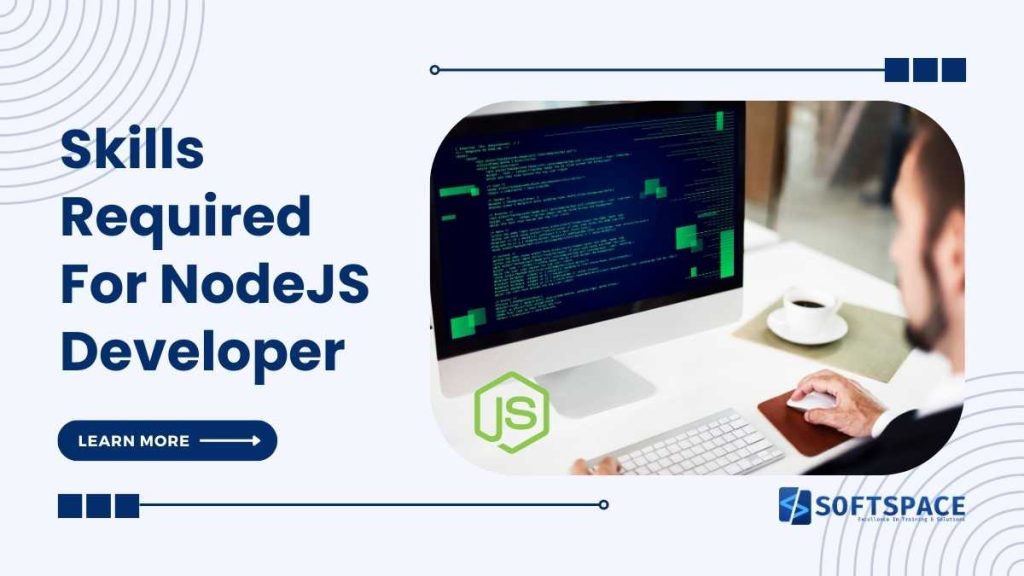Are you interested in pursuing a career in web development, but feel overwhelmed by full stack developer roles and responsibilities involved? Look no further! In this ultimate guide, we will demystify the world of full-stack developers and provide a comprehensive understanding of their roles and responsibilities.
Full-stack developers are the Swiss Army knives of the web development world. They specialize in both front-end and back-end development, making them versatile and capable of handling all aspects of a website or application.
From designing user interfaces to writing server code, full-stack developers have a wide range of skills that allow them to bring a project from conception to completion.
In this guide, we will delve into the specific technical skills required to become a successful full-stack developer, such as proficiency in programming languages, frameworks, and databases. We will also explore the soft skills that are necessary to excel in this role, such as problem-solving, collaboration, and communication.
Whether you’re a beginner looking to enter the field of web development or an experienced developer seeking to expand your skill set, this guide will provide you with the knowledge and resources you need to understand and excel in the world of full-stack development.
Table of Contents
What is a full stack developer?
A full stack developer is a web developer who has expertise in both front-end and back-end development. They have a deep understanding of how the different components of a website or application work together and are capable of handling all aspects of the development process.
This includes designing user interfaces, writing server-side code, and managing databases.
To become a full-stack developer, one must have a solid understanding of programming languages such as HTML, CSS, JavaScript, and a back-end language like Python, Ruby, or PHP.
They should also be familiar with frameworks and libraries such as React, Angular, or Node.js. Additionally, knowledge of databases like MySQL or MongoDB is essential for managing data.
Full-stack developers are often involved in every stage of the development process, from gathering requirements and designing the user interface to implementing the back-end logic and deploying the application. Their versatility and breadth of knowledge make them valuable assets to any development team.
Skills required for a full stack developer
To excel as a full stack developer, one must possess a combination of technical and soft skills. Let’s take a closer look at the key skills required to succeed in this role.
Technical Skills
- Front-end Development: Full-stack developers should have a strong command of front-end technologies such as HTML, CSS, and JavaScript. They should be able to create responsive and visually appealing user interfaces.
- Back-end Development: Proficiency in a back-end language like Python, Ruby, or PHP is crucial for full stack developers. They should be able to write efficient server-side code and handle data storage and retrieval.
- Frameworks and Libraries: Familiarity with popular front-end frameworks and libraries like React, Angular, or Vue.js is essential for building dynamic and interactive user interfaces. Knowledge of back-end frameworks like Express.js or Django can also be beneficial.
- Databases: Full-stack developers should have a good understanding of databases and how to interact with them. Knowledge of SQL or NoSQL databases like MySQL, MongoDB, or PostgreSQL is important for managing data effectively.
- Version Control: Proficiency in Git or other version control systems is necessary for collaborating with other developers and managing code changes.
Soft Skills
- Problem Solving: Full-stack developers should possess strong problem-solving skills to overcome challenges and find optimal solutions to complex problems.
- Collaboration: As full-stack developers often work in teams, the ability to collaborate and communicate effectively with other team members is crucial for successful project completion.
- Adaptability: Full-stack developers should be adaptable and able to quickly learn new technologies and frameworks as the web development landscape evolves.
- Attention to Detail: Paying attention to detail is important in web development to ensure that the application functions as intended and meets the requirements of the client or end-user.
- Communication: Strong communication skills are essential for full-stack developers to effectively convey their ideas, requirements, and progress to both technical and non-technical stakeholders.
Full stack developer Roles and responsibilities
Full stack developer roles and responsibilities are not limited. Throughout the development process, they have to look after multiple aspects of building a complete online web app. Let’s explore some of the key tasks they are typically responsible for:
Designing User Interfaces
One of the primary responsibilities of a full stack developer is designing user interfaces that are visually appealing, intuitive, and responsive. They should have a good understanding of UI/UX principles and be able to create designs that provide a seamless user experience.
Implementing Front-end Functionality
Full-stack developers are responsible for implementing the front-end functionality of a website or application. This includes writing HTML, CSS, and JavaScript code to create interactive elements, handle user input, and manage data presentation.
Developing Back-end Logic
Full-stack developers are also responsible for developing the back-end logic of a website or application. This involves writing server-side code to handle data processing, business logic, and integration with external services or APIs.
Database Management
Full-stack developers should have a good understanding of databases and how to interact with them. They are responsible for designing and managing the database structure, creating efficient queries, and ensuring data integrity and security.
Testing and Debugging
Full-stack developers are responsible for testing and debugging their code to ensure that the application functions as intended. They should be able to identify and fix any issues or bugs that may arise during the development process.
Deployment and Maintenance
Full-stack developers are often involved in deploying the application to a production environment and ensuring its smooth operation. They should have a good understanding of server management and be able to monitor and maintain the application’s performance and security.
Advantages of hiring a full stack developer
Hiring a full-stack developer can offer several advantages to a development team or organization. The full stack developer roles and responsibilities can vary with respect to technology and the front-end/back-end roles. Let’s explore some of the key benefits:
Versatility and Efficiency
Full-stack developers are capable of handling both front-end and back-end development tasks, making them versatile and efficient team members. They can take complete ownership of a project, reducing the need for multiple specialized developers.
Cost-effectiveness
By hiring a full-stack developer, organizations can save costs as they only need to pay for a single developer who can handle a wide range of tasks. This eliminates the need to hire multiple developers with specialized skill sets.
Seamless Collaboration
Full-stack developers can bridge the gap between front-end and back-end developers, facilitating seamless collaboration and communication within the development team. This leads to a more efficient and cohesive development process.
Faster Development
With their ability to handle all aspects of a project, full-stack developers can streamline the development process and deliver projects faster. They can easily switch between different tasks, reducing dependencies and bottlenecks.
Adaptability and Learning Opportunities
Full-stack developers are constantly learning and adapting to new technologies and frameworks. This adaptability allows them to stay up-to-date with the latest trends and best practices in web development.
Challenges faced by full-stack developers
While full-stack development offers numerous advantages, it also comes with its own set of challenges. Let’s explore some of the common challenges faced by full-stack developers:
Learning Curve
Full-stack development requires a broad range of skills, which can make the learning curve steep. Developers need to invest time and effort to gain proficiency in multiple programming languages, frameworks, and databases.
Keeping Up with Technology
The web development landscape is constantly evolving, with new frameworks, tools, and languages being introduced regularly. Full-stack developers need to stay updated with the latest trends and continuously learn new technologies to remain competitive.
Balancing Depth and Breadth
While full-stack developers have the advantage of being versatile, they may face challenges in achieving deep expertise in specific areas. Balancing the need for breadth of knowledge with the desire to specialize can be a challenge for full-stack developers.
Time Management
As full-stack developers are responsible for multiple aspects of a project, time management can be a challenge. Prioritizing tasks, managing deadlines, and ensuring efficient use of time can require careful planning and organization.
Burnout
The wide range of responsibilities and the need to constantly learn and adapt can sometimes lead to burnout for full-stack developers. It’s important to prioritize self-care and strike a healthy work-life balance to avoid burnout.
Tools and technologies used by full-stack developers
Full-stack developers rely on a variety of tools and technologies to effectively carry out their roles and responsibilities. There are various full stack development combinations that you must know about. Let’s explore some of the key tools and technologies used by full-stack developers:
Integrated Development Environments (IDEs)
IDEs such as Visual Studio Code, Atom, or JetBrains’ WebStorm provide full-stack developers with features like code auto-completion, debugging capabilities, and integration with version control systems. These tools enhance productivity and streamline the development process.
Version Control Systems
Version control systems like Git are essential for full-stack developers to manage code changes, collaborate with other developers, and track the history of code revisions. They allow for easy collaboration and help ensure the integrity and stability of the codebase.
Front-end Frameworks and Libraries
Front-end frameworks and libraries like React, Angular, or Vue.js provide full-stack developers with pre-built components, state management, and efficient rendering. These tools help streamline front-end development and enhance the user experience.
Back-end Frameworks
Back-end frameworks like Express.js, Django, or Ruby on Rails provide full-stack developers with a set of tools and libraries for building server-side applications. These frameworks simplify the development process and provide a solid foundation for building robust back-end systems.
Databases
Full-stack developers work with a variety of databases, such as MySQL, MongoDB, or PostgreSQL, to store and retrieve data. These databases provide structured or unstructured data storage options, depending on the needs of the application.
Deployment Tools
Deployment tools like Docker or Heroku simplify the process of deploying applications to production environments. These tools automate tasks such as containerization, scaling, and monitoring, making it easier for full-stack developers to deploy and maintain their applications.
How to become a full stack developer?
Becoming a full-stack developer requires a combination of technical knowledge and practical experience. You must know the complete full stack developer roles and responsibilities before taking up the profile. Here are some steps you can take to kickstart your journey as a full-stack developer:
1. Learn the Basics
Start by learning the basics of front-end and back-end development. Familiarize yourself with HTML, CSS, JavaScript, and a back-end language like Python, Ruby, or PHP. Explore frameworks and libraries like React, Angular, or Node.js to enhance your skills.
2. Gain Practical Experience
Practice what you learn by working on projects of your own. Build simple websites or applications to apply your knowledge and gain hands-on experience. This will help solidify your understanding and provide a portfolio to showcase your skills.
3. Expand Your Knowledge
Continuously expand your knowledge by learning new technologies, frameworks, and tools. Stay updated with the latest trends in web development and explore new areas of interest. This will help you stay competitive and adaptable in the fast-evolving field.
4. Collaborate and Network
Collaborate with other developers and participate in open-source projects or online communities. This will help you learn from others, gain valuable insights, and expand your professional network. Networking can lead to job opportunities and mentorship.
5. Develop Problem-Solving Skills
Focus on developing your problem-solving skills, as they are crucial for full-stack developers. Solve coding challenges, tackle complex problems, and practice critical thinking. This will help you approach development tasks with a strategic and analytical mindset.
6. Build a Portfolio
Create a portfolio showcasing your projects and skills. Include both front-end and back-end projects to demonstrate your versatility as a full-stack developer. Highlight your achievements, the technologies you worked with, and the impact of your work.
7. Stay Curious and Keep Learning
Never stop learning and stay curious about new technologies and trends. Attend webinars, workshops, or conferences to stay updated with the latest developments in the field. This continuous learning mindset will set you apart as a dedicated and adaptable full-stack developer.
Full stack development resources and courses
Here are some resources and online courses that can help you on your journey to becoming a full-stack developer:
Online Courses
- Coursera: Offers a wide range of full-stack development courses from top universities and institutions.
- Udemy: Provides a variety of full-stack development courses taught by industry professionals.
- freeCodeCamp: Offers a free full-stack development curriculum with hands-on projects and certifications.
- Codecademy: Provides interactive full-stack development courses and projects for beginners and advanced learners.
Online Resources
- MDN Web Docs: A comprehensive resource for web development, including guides and tutorials on full-stack development.
- Stack Overflow: A popular Q&A platform where developers can ask and answer questions related to full stack development.
- GitHub: A platform for hosting and collaborating on code repositories. Explore open-source full-stack projects and contribute to them.
Conclusion
Full-stack development offers a world of opportunities for those interested in web development. By mastering both front-end and back-end skills, full-stack developers can bring projects from conception to completion. They are versatile, adaptable, and valuable assets to any development team or organization.
The full stack developer roles and responsibilities vary from organization to organization. you may have a limited role in the complete development or may be involved in only one side of the development [fromt-end or back-end]. In any case, the learning curve is vast and you need to ace the programming game to become a super full stack developer.

13+ Yrs Experienced Career Counsellor & Skill Development Trainer | Educator | Digital & Content Strategist. Helping freshers and graduates make sound career choices through practical consultation. Guest faculty and Digital Marketing trainer working on building a skill development brand in Softspace Solutions. A passionate writer in core technical topics related to career growth.




